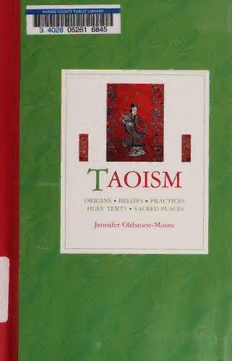
Taoism. origins, beliefs, practices, holy texts, sacred places PDF
Preview Taoism. origins, beliefs, practices, holy texts, sacred places
II 1 1? If: : i ^ 402 8 0 5261 6845 ORIGINS • BELIEFS • PRACTICES HOLY TEXTS • SACRED PLACES Jennifer Oldstone-Moore Taoism is a religious tradition that has taken a variety of forms, including philosophical speculations, esoteric rituals, and disciplines of personal cultivation. At the heart of this diversity is the Tao, or Way—the source of all creation and the inexorable pattern of change by which the universe comes into being. Taoism emphasizes the need for us to act in accordance with the Tao, to move with rather than against the grain of nature. When we do this, we can attain personal tranquillity, enhanced health and, for a few, perhaps even the means to vanquish death. This concise, illustrated guide is an accessible introduction to the key themes of Taoism—including the life of its founding sage Laozi and his teachings, the influential sacred writings of the Tao Te Ching and Zhuangzi^ the concept of wu wei (non¬ interference), the cultivation of simplicity and detachment, the attainment of harmony and the quest for immortality. Jennifer Oldstone-Moore provides a unique distillation of this ancient and compelling tradition, from its origins in ancient China to its place in society today. The book includes special documentary sections presenting extracts from and summaries of key texts and other invaluable reference material illuminating central features of the religion. $17.95 299.514 Old □Idstone-Moore, Jennifer. Taoism : origins, beliefs, practices, holy texts, sacred places MAR 0 200^1 1 $17.95 ocm51505645 Digitized by the Internet Archive in 2018 with funding from Kahle/Austin Foundation https://archive.0rg/detaiIs/taoismoriginsbelOOOOolds Taoism ORIGINS • BELIEFS • PRACTICES HOLY TEXTS • SACRED PLACES o Taoism ORIGINS • BELIEFS • PRACTICES HOLY TEXTS • SACRED PLACES Jennifer Oldstone-Moore OXPORD UNIVERSITY PRESS Oxford University Press Oxford New York Auckland Bangkok Buenos Aires Cape Town Chennai Dar es Salaam Delhi Hong Kong Istanbul Karachi Kolkata Kuala Lumpur Madrid Melbourne Mexico City Mumbai Nairobi Sao Paolo Shanghai Taipei Tokyo Toronro Copyright © Duncan Baird Publishers 2003 Text copyright © Jennifer Oldstone-Moore 2003 Commissioned artwork copyright © Duncan Baird Publishers 2003 For copyright of photographs see page 112, which is to be regarded as an extension of this copyright First published in the United States of America in 2003 by Oxford University Press, Inc. 198 Madison Avenue, New York, N.Y 10016—4314 Oxford is a registered trademark of Oxford University Press All rights reserved. No part of this publication may be reproduced, stored in a retrieval system, or transmitted, in any form or by any means, electronic, mechanical, photocopying, recording, or otherwise, without prior written permission of Oxford University Press. Conceived, created, and designed by Duncan Baird Publishers, London, England Library of Congress Cataloging-in-Publication Data is available ISBN; 0-19-521933-3 Managing Editor: Christopher Westhorp Project Editor: Diana Loxley Design: Cobalt id Picture Researcher: Julia Ruxton Typeset in Garamond Three Color reproduction by Scanhouse, Malaysia Printed and bound in Singapore by Imago NOTES The abbreviations BCE and CE are used throughout this book: BCE Before the Common Era (the equivalent of BC) CE Common Era (the equivalent of AD) Wade-Giles transliterations have generally been used throughout, with the exception of some place names. For Pinyin equivalents please see page 106. 10 987654321 Page 2: A worshiper in a popular Taoist temple in Taipei. Religious practices in such temples are highly localized and are generally performed on an informal and individual basis rather than conforming to set rules. CONTENTS Introduction 6 Origins and Historical Development 12 Extract and Commentary 20 Aspects of the Divine 22 Extract and Commentary 30 Sacred Texts 32 Extract and Commentary 40 Sacred Persons 42 Extract and Commentary 30 Ethical Principles 52 Extract and Commentary 60 Sacred Space 62 Extract and Commentary 70 Sacred Time 72 Extract and Commentary 82 Death and the Afterlife 84 Extract and Commentary 94 Society and Religion 96 Extract and Commentary 104 Transliterations Glossary 106 General Bibliography 107 Index 108 Acknowledgments and Picture Credits 112 6 7 INTRODUCTION The principal focus of Taoism is the Tao (meaning “Way,” or “path”), which refers to a nameless, formless, all-pervasive power which brings all things into being and reverts them back into non-being in an eternal cycle. The tradition stresses the importance of following the way of the Tao—that is, of taking no action that is contrary to nature, and of finding one’s place in the natural order of things. Understanding the pattern of the Tao includes the ability of trained specialists to control spiritual powers, which are either inferior to the Tao or emanations of it. Overall, the concept of the Tao provides a structure for making sense of the change of seasons, the life-cycle of creation, and the individual’s place in the world. Taoism has had a significant impact on the develop¬ ment of Chinese civilization and its ideas pervade virtually all aspects of the culture (see pp.97—103). Some of Taoism’s most surprising contributions to Chinese and world civilization have been scientific. In the course of deciphering the pattern of the natural world in order to benefit humankind, a number of important discoveries were made. For example, the search for the “elixir of immortality” led not only to the invention of gunpowder (see p.lOO), but also to notable advances in Chinese
